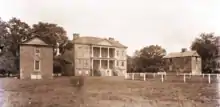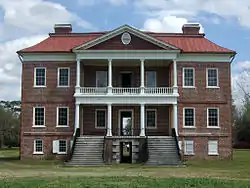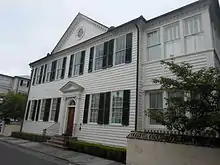Drayton Hall
Drayton Hall is an 18th-century plantation house located on the Ashley River about 15 miles (24 km) northwest of Charleston, South Carolina, and directly across the Ashley River from North Charleston, west of the Ashley in the Lowcountry. An example of Palladian architecture in North America and the only plantation house on the Ashley River to survive intact through both the Revolutionary and Civil wars, it is a National Historic Landmark.

Drayton Hall | |
 Drayton Hall (front) | |
| Nearest city | Charleston, South Carolina and North Charleston, South Carolina |
|---|---|
| Coordinates | 32°52′15.24″N 80°4′34.68″W |
| Built | 1747–1752 |
| Architectural style | Palladian |
| NRHP reference No. | 66000701 |
| Significant dates | |
| Added to NRHP | October 15, 1966[1] |
| Designated NHL | October 9, 1960[2] |
Description
The house has a double projecting portico on the west facade, which faces away from the river and toward the land side approach from Ashley River Road. The portico resembles a similar feature at the Villa Cornaro near Venice, Italy, designed by Renaissance architect Andrea Palladio in 1551. The floor plan of Drayton Hall is Palladian-inspired as well, perhaps derived from Plate 38 of James Gibbs' A Book of Architecture,[3] the influential pattern-book published in London in 1728.[4] A large central entrance stair hall with a symmetrical divided staircase is backed by a large salon, flanked by square and rectangular chambers.[5] Pedimented chimney-pieces in the house echo designs of Inigo Jones.[6]
History
The mansion was built for the grandfather of John Drayton, John Drayton Sr. (c. 1715–1779; son of Thomas and Ann Drayton) after he bought the property in 1738.[7] As the third son in his family, he knew he was unlikely to inherit his own nearby birthplace, now called Magnolia Plantation and Gardens.

For many decades, the house was thought to have been begun in 1738 and completed in 1752. In 2014, an examination of wood cores showed that the attic timbers were cut from trees felled in the winter of 1747–48. Because the attic framing would have to have been in place well before the completion of the interior finishes, the house is now thought to have been occupied by the early 1750s.[8] The seven-bay, double-pile plantation house is within a 630-acre (2.5 km2) site that is part of the plantation based on indigo and rice and the former site of 13 slave cabins believed to have housed approximately 78 slaves. Seven generations of Drayton heirs preserved the house, though the flanking outbuildings have not survived: an earthquake destroyed the laundry house in 1886, and a hurricane destroyed the kitchen in 1893.[9] John Drayton bought considerable property nearby from his nephew William Drayton, Sr., after the latter was appointed as chief justice of the Province of East Florida in the early 1770s and was leaving South Carolina. John Drayton consolidated the various Drayton properties, and his descendants have controlled them since.
The house is located in the Ashley River Historic District, it was declared a National Historic Landmark in 1960.[10] Drayton Hall is owned by the National Trust for Historic Preservation and managed by the Drayton Hall Preservation Trust, which opened the house to the public in 1976.
Gallery
 Drayton Hall plantation house viewed from behind one of several live oaks.
Drayton Hall plantation house viewed from behind one of several live oaks. Drayton Hall plantation house by Carol M. Highsmith.
Drayton Hall plantation house by Carol M. Highsmith. The Ashley river, just behind Drayton Hall
The Ashley river, just behind Drayton Hall Rear view of Drayton Hall
Rear view of Drayton Hall Main living space at Drayton Hall
Main living space at Drayton Hall Drayton Hall staircase
Drayton Hall staircase
See also
References
- "National Register Information System". National Register of Historic Places. National Park Service. January 23, 2007.
- "Drayton Hall". National Historic Landmark summary listing. National Park Service. Archived from the original on October 23, 2007. Retrieved March 21, 2008.
- James Gibbs, A Book of Architecture, containing designs of buildings and ornaments (London, 1728; repr. New York, 2008), ISBN 0-486-46601-9.
- Carl I. Gable, "Searching for Sources: What are Drayton Hall's Palladian Roots?" Palladiana: Journal of the Center for Palladian Studies in America, Inc., vol. 4, no. 1 (Fall 2009), p. 5.
- Drayton Hall
- "Drayton Hall". blogs.cofc.edu. Retrieved April 29, 2022.
- "Seven Generations of the Drayton Family: From the Colonial Period to Modern Day" Archived March 3, 2011, at the Wayback Machine, Drayton Hall website
- Behre, Robert (May 10, 2014). "How old is your house? The wood would know..." Post & Courier. Charleston, South Carolina. Retrieved May 10, 2014.
- "Drayton Hall", South Carolina Plantations, SCIway
- James Dillon (August 1976). "National Register of Historic Places Inventory-Nomination" (pdf). National Park Service.
{{cite journal}}: Cite journal requires|journal=(help) and Accompanying five photos, exterior, from 1975 (32 KB)
External links
- Drayton Hall homepage
- The Center for Palladian Studies in America, Inc.
- Drayton Hall, Charleston County (S.C. Hwy. 61, Charleston vicinity) (with 37 photographs), at South Carolina Department of Archives and History
- Great Buildings on-line: Drayton Hall
- Historic American Buildings Survey (HABS) No. SC-377, "Drayton Hall, Ashley River Road (State Route 61), Charleston, Charleston County, SC", 12 photos, 14 measured drawings, 19 data pages, 1 photo caption page
- South Carolina Plantations: Drayton Hall

